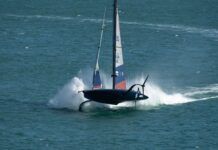
My closet is full of boat shoes and sailing boots that are in excellent condition on the topsides, but to a sole, their bottoms have become hard and slippery. Is there any known cure short of replacement?
Last week, when heading out for a sail on an unfamiliar small boat, I put 80-grit sandpaper on my Makita sander and worked the bottoms of a pair of old Tobago sailing sandals, until the sole felt less slippery. On board, the sandals gave me much more traction than they had for a very long while. Does Practical Sailor have any other possible solutions?
Bill Crowley
Clarsa, 1979 Venture Newport 23
Sailing Education Adventures, www.sfsailing.org
Napa, Calif.
Hardened sailing-shoe soles are not limited to just a few brands; most grippy soles lose their stick after a while. Soles designed for high-traction gripping are typically made of a soft rubber. This soft, tacky rubber wears down more quickly, eventually hardening over time. Sailing shoes are regularly subjected to salt water, abrasive nonskid surfaces, sun, and numerous wet-dry cycles; a soft material in a harsh environment obviously wont last long.
None of the sailing-shoe makers we contacted could offer any better tips for returning grip to a hardened sole. However, rather than ditching a perfectly good upper, we recommend having the shoes re-soled. There are a number of re-soling businesses online-some specialize in sailing shoes-and chances are good that youll find a few local cobblers in your own area that can do it as well.
Since we have a closetful of old sailing moccasins, sandals, and athletic shoes, weve decided to do a review of re-soling businesses (online and local). We welcome reader recommendations; email [email protected].
SSB Mounting
What is the recommended way to mount GTO-15 SSB antenna wire to the backstay without sacrificing a good contact or encouraging corrosion? Everybody seems to have a different opinion, including: hose clamps, lots of tape, and electricians putty (coax-seal).
Mike Hirko
Destiny, Tayana Vancouver 42
Gig Harbor, Wash.
Single-strand, high-voltage wire, such as Ancor GTO-15, is a good choice for connecting antenna tuners to a backstay or long wire antenna. The physical connection between the isolated stainless-steel wire or rod rigging can be tricky, both due to dissimilar metal issues and diameter differences.
If you are installing insulators on a backstay, its a good time to have a rigger slip a Nicopress fitting on the stay, close to the lower terminal end. The second portion of the dual-slot Nicopress receives a short, tinned, stranded copper wire of about the same diameter. Once crimped, the rugged pigtail connection (about 6 inches long) should be clamped to the backstay and fitted with a heavy-duty ring terminal. The GTO-15 lead is also fitted with a ring terminal, and these can be fastened together with a small copper nut and screw.
If the backstay insulators are already in place, the tinned, stranded GTO-15 conductor can be clamped to the backstay with multiple hose clamps. Though less elegant and durable than the Nicopress, the GTO-15 is a functional alternative, but it should be checked often for broken strands and corrosion. Coatings can help, but dielectrics can impede signal propagation.








































resoling is not easy but there is a market in sailing, climbing and court shoes. Badminton shoes can be 150 to 200 dollars for top brands. I have found that silicone spray to the soles, then sealing them in plastic for more than a week…then repeat, helps soften the rubber.